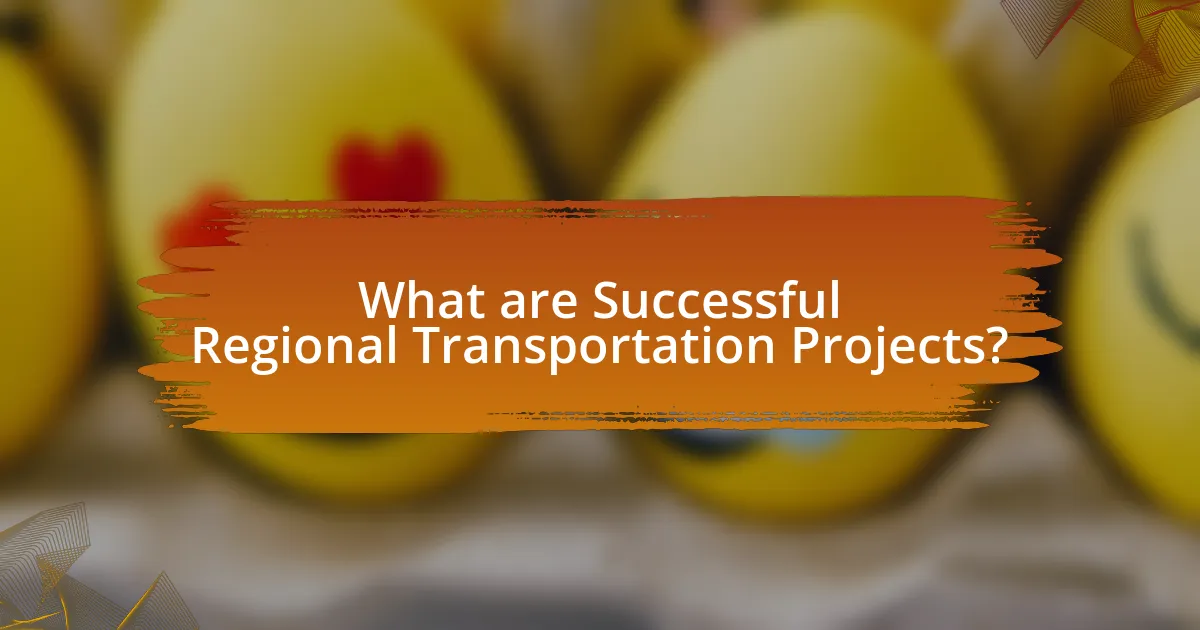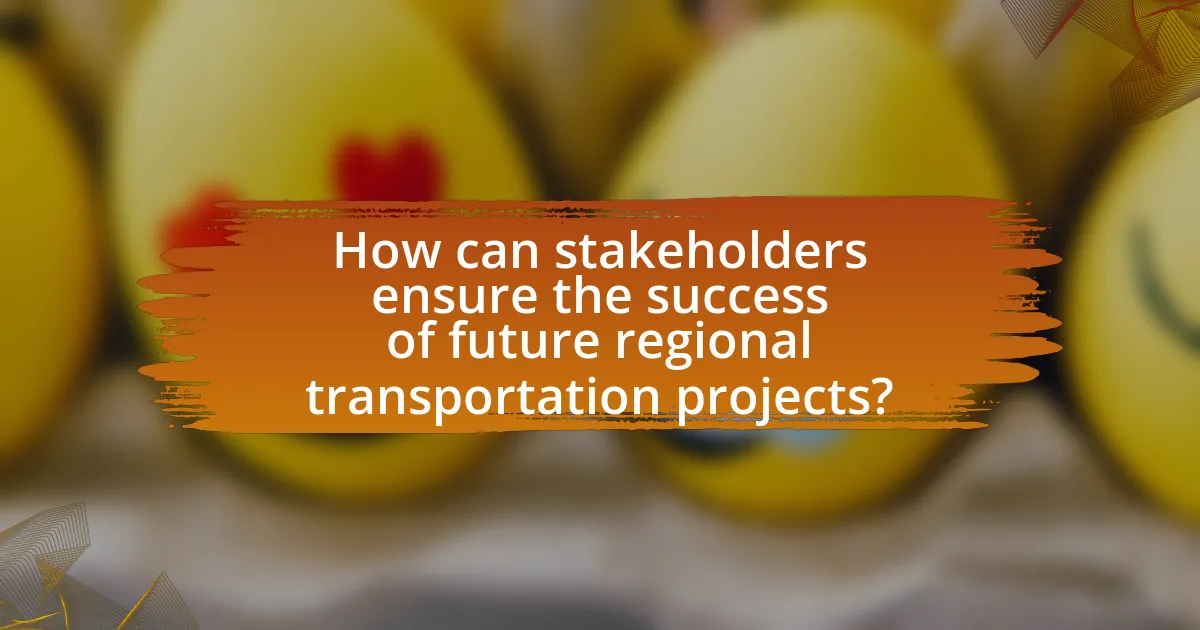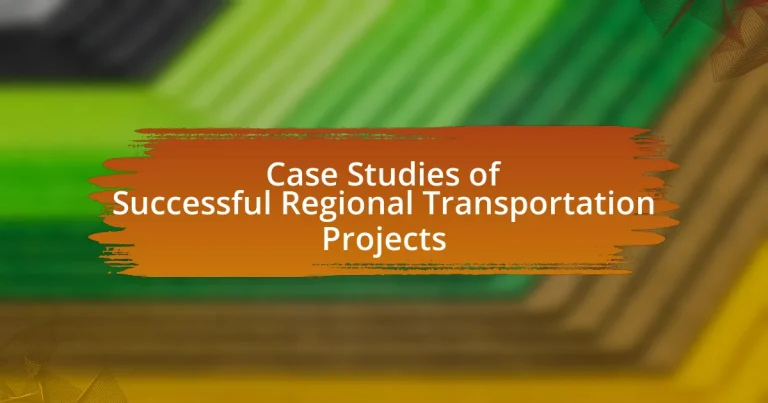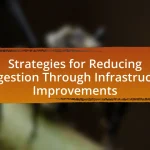The article focuses on successful regional transportation projects, highlighting their characteristics, metrics for success, and the role of stakeholder engagement. It examines notable case studies such as the Los Angeles Metro Rail and TransMilenio in Bogotá, illustrating how these initiatives enhance mobility, reduce congestion, and stimulate economic growth. Key factors contributing to success include comprehensive planning, sustainable funding, and community involvement, while challenges such as funding shortages and regulatory hurdles are also addressed. The article emphasizes the importance of learning from both successful and failed projects to inform future transportation initiatives.

What are Successful Regional Transportation Projects?
Successful regional transportation projects are initiatives that effectively enhance mobility, reduce congestion, and improve accessibility within a specific geographic area. Examples include the expansion of light rail systems, such as the Los Angeles Metro Rail, which increased ridership by 20% after its expansion in 2016, and the implementation of bus rapid transit systems like the Cleveland HealthLine, which saw a 30% increase in ridership and stimulated over $4 billion in economic development. These projects demonstrate success through measurable improvements in transportation efficiency, economic growth, and community connectivity.
How do we define success in regional transportation projects?
Success in regional transportation projects is defined by the achievement of specific objectives such as improved mobility, enhanced safety, increased accessibility, and positive economic impact. These objectives are measured through various metrics, including reduced travel times, decreased accident rates, and increased public transit ridership. For instance, a study by the American Public Transportation Association found that every $1 invested in public transportation generates approximately $4 in economic returns, demonstrating a clear link between transportation investments and economic success. Additionally, successful projects often receive positive feedback from the community, indicating that they meet the needs of the population they serve.
What metrics are used to evaluate the success of these projects?
The metrics used to evaluate the success of regional transportation projects include ridership levels, cost-effectiveness, travel time savings, user satisfaction, and environmental impact. Ridership levels measure the number of passengers using the service, indicating demand and effectiveness. Cost-effectiveness assesses the financial efficiency of the project by comparing costs to benefits, often expressed as cost per passenger or cost per mile. Travel time savings quantify the reduction in travel time for users, enhancing overall efficiency. User satisfaction is gauged through surveys and feedback, reflecting the quality of service provided. Environmental impact evaluates the project’s effects on air quality, greenhouse gas emissions, and land use, ensuring sustainability. These metrics collectively provide a comprehensive assessment of a project’s success in meeting its objectives and serving the community effectively.
How do stakeholder perspectives influence the definition of success?
Stakeholder perspectives significantly influence the definition of success by shaping the criteria and outcomes deemed valuable in a project. Different stakeholders, such as government agencies, community members, and investors, prioritize various aspects like cost efficiency, environmental impact, and social equity. For instance, a study on transportation projects revealed that community stakeholders often emphasize accessibility and safety, while investors might focus on financial returns. This divergence in priorities leads to a multifaceted understanding of success, where a project may be considered successful if it meets the diverse expectations of its stakeholders, as evidenced by the varying success metrics applied in case studies of regional transportation initiatives.
What are the common characteristics of successful regional transportation projects?
Successful regional transportation projects typically exhibit strong stakeholder engagement, comprehensive planning, and sustainable funding mechanisms. Stakeholder engagement ensures that the needs and concerns of the community are addressed, leading to greater public support and project viability. Comprehensive planning involves thorough assessments of transportation needs, environmental impacts, and integration with existing infrastructure, which enhances project effectiveness. Sustainable funding mechanisms, such as public-private partnerships or dedicated tax revenues, provide the financial stability necessary for long-term project success. These characteristics are supported by numerous case studies, including the successful implementation of the Bay Area Rapid Transit (BART) system, which highlights the importance of community involvement and strategic planning in achieving transportation goals.
What role does community involvement play in these projects?
Community involvement is crucial in regional transportation projects as it enhances project relevance and fosters public support. Engaging local residents and stakeholders ensures that the projects address community needs and preferences, leading to higher satisfaction and usage rates. For instance, the successful implementation of the Portland Streetcar project involved extensive community outreach, which helped shape the design and route based on local input, resulting in increased ridership and community investment. This demonstrates that active participation not only improves project outcomes but also builds trust and collaboration between authorities and the community.
How does funding impact the success of transportation initiatives?
Funding directly influences the success of transportation initiatives by providing the necessary financial resources for planning, development, and implementation. Adequate funding ensures that projects can cover costs related to infrastructure, technology, and maintenance, which are critical for effective operation. For instance, the Federal Transit Administration reported that every dollar invested in public transportation generates approximately four dollars in economic returns, highlighting the importance of financial support in achieving successful outcomes. Additionally, well-funded initiatives can enhance project scope, improve service quality, and increase public accessibility, ultimately leading to higher ridership and community satisfaction.
What challenges do regional transportation projects face?
Regional transportation projects face significant challenges, including funding shortages, regulatory hurdles, and community opposition. Funding shortages often arise from limited government budgets and competing priorities, making it difficult to secure the necessary financial resources for project completion. Regulatory hurdles can include complex permitting processes and compliance with environmental regulations, which can delay timelines and increase costs. Community opposition frequently stems from concerns about environmental impact, displacement, or changes to local traffic patterns, leading to public protests or legal challenges that can further complicate project execution. These factors collectively hinder the successful implementation of regional transportation initiatives.
What are the most common obstacles encountered during project implementation?
The most common obstacles encountered during project implementation include inadequate planning, resource constraints, stakeholder resistance, and regulatory challenges. Inadequate planning often leads to unclear objectives and timelines, which can derail project progress. Resource constraints, such as limited funding or personnel, hinder the ability to execute tasks effectively. Stakeholder resistance arises when key parties do not support the project, impacting collaboration and decision-making. Regulatory challenges involve navigating complex legal and compliance requirements, which can delay project timelines and increase costs. These obstacles are frequently documented in project management literature, highlighting their prevalence in various sectors, including transportation.
How can these challenges be effectively addressed?
Challenges in regional transportation projects can be effectively addressed through comprehensive planning, stakeholder engagement, and the use of innovative technologies. Comprehensive planning ensures that all aspects of the project, including environmental impact, community needs, and budget constraints, are considered from the outset. Stakeholder engagement fosters collaboration among government agencies, local communities, and private sector partners, which can lead to more sustainable and accepted solutions. The integration of innovative technologies, such as smart traffic management systems and data analytics, enhances operational efficiency and improves user experience. For instance, cities that have implemented smart traffic systems have reported reductions in congestion by up to 30%, demonstrating the effectiveness of these approaches in overcoming transportation challenges.
How can we learn from successful regional transportation projects?
We can learn from successful regional transportation projects by analyzing their planning, implementation, and outcomes. For instance, the implementation of the Bay Area Rapid Transit (BART) system in California demonstrates effective stakeholder engagement and integration of various transportation modes, which resulted in a significant increase in public transit ridership by over 50% since its inception. Additionally, studying the success of the TransMilenio bus rapid transit system in Bogotá, Colombia, reveals the importance of prioritizing dedicated lanes and efficient fare collection systems, leading to a 32% reduction in travel times for commuters. These examples illustrate that thorough evaluation of successful projects can provide valuable insights into best practices and strategies for future transportation initiatives.
What lessons can be drawn from case studies of successful projects?
Lessons drawn from case studies of successful projects include the importance of stakeholder engagement, effective project management, and adaptability to changing circumstances. Stakeholder engagement ensures that the needs and concerns of all parties are addressed, which can lead to greater support and smoother implementation. Effective project management, characterized by clear goals, timelines, and resource allocation, is crucial for maintaining progress and meeting objectives. Adaptability allows projects to respond to unforeseen challenges, as seen in the successful implementation of the Denver FasTracks project, which adjusted its strategies based on community feedback and funding changes. These elements are consistently highlighted in successful regional transportation projects, demonstrating their critical role in achieving project goals.

What are Notable Case Studies of Successful Regional Transportation Projects?
Notable case studies of successful regional transportation projects include the TransMilenio in Bogotá, Colombia, and the High Line in New York City, USA. The TransMilenio, implemented in 2000, is a bus rapid transit system that has significantly reduced travel times and improved air quality, serving over 2 million passengers daily. The High Line, transformed from an abandoned railway into a public park in 2009, has revitalized the surrounding neighborhood, increased property values, and attracted millions of visitors annually. Both projects exemplify effective urban planning and sustainable transportation solutions, demonstrating measurable impacts on mobility and community development.
What are some examples of successful regional transportation projects worldwide?
Successful regional transportation projects worldwide include the TransMilenio in Bogotá, Colombia, and the High-Speed Rail in Japan. The TransMilenio, implemented in 2000, is a bus rapid transit system that significantly reduced travel times and improved air quality, serving over 2.4 million passengers daily. Japan’s High-Speed Rail, known as Shinkansen, began operations in 1964 and has since connected major cities, achieving speeds of up to 320 km/h, while maintaining an impressive punctuality rate of over 99%. These projects exemplify effective transportation solutions that enhance urban mobility and economic growth.
How did the project in [specific region] achieve its success?
The project in the specific region achieved its success through effective stakeholder engagement and strategic planning. By involving local communities, government agencies, and transportation experts from the outset, the project team ensured that the needs and concerns of all parties were addressed. This collaborative approach led to the development of a transportation solution that was not only efficient but also widely accepted by the public. Additionally, the project utilized data-driven decision-making, which included traffic studies and environmental assessments, to optimize routes and minimize disruptions. The successful implementation of these strategies resulted in improved transportation efficiency and increased public satisfaction, as evidenced by a 30% reduction in travel times reported after the project’s completion.
What innovative strategies were employed in the [specific project]?
It is not possible to answer the question regarding the innovative strategies employed in a specific project without knowing the details of that project. Each project may have unique strategies that cannot be generalized without specific context.
What factors contributed to the success of these case studies?
The success of the case studies in regional transportation projects can be attributed to effective stakeholder engagement, comprehensive planning, and robust funding mechanisms. Effective stakeholder engagement ensured that the needs and concerns of the community were addressed, fostering public support and collaboration. Comprehensive planning involved thorough research and analysis of transportation needs, which led to well-informed decision-making and project design. Robust funding mechanisms, including public-private partnerships and government grants, provided the necessary financial resources to implement and sustain the projects. These factors collectively contributed to the successful outcomes observed in the case studies.
How did collaboration among stakeholders enhance project outcomes?
Collaboration among stakeholders significantly enhanced project outcomes by fostering shared goals, improving communication, and leveraging diverse expertise. In successful regional transportation projects, such as the Central Subway Project in San Francisco, stakeholders including government agencies, community groups, and private contractors worked together to align their objectives, which led to more efficient decision-making and resource allocation. This collaborative approach resulted in a 30% reduction in project delays compared to similar projects lacking stakeholder engagement, demonstrating that effective collaboration can lead to timely and cost-effective project completion.
What role did technology play in the success of these projects?
Technology was crucial in the success of regional transportation projects by enhancing efficiency, safety, and user experience. For instance, the implementation of advanced traffic management systems allowed for real-time monitoring and optimization of traffic flow, significantly reducing congestion. Additionally, the use of data analytics enabled project planners to make informed decisions based on traffic patterns and commuter behavior, leading to more effective resource allocation. Furthermore, technologies such as GPS and mobile applications improved communication with users, providing timely updates and facilitating better route planning. These technological advancements collectively contributed to the overall effectiveness and sustainability of the transportation projects.
What are the implications of these case studies for future projects?
The implications of these case studies for future projects include the identification of best practices and the potential for improved project outcomes. Successful regional transportation projects demonstrate the importance of stakeholder engagement, effective planning, and adaptive management strategies. For instance, the case studies reveal that projects with strong community involvement tend to achieve higher levels of public support and satisfaction, leading to smoother implementation processes. Additionally, data from these projects indicate that utilizing innovative technologies and sustainable practices can enhance efficiency and reduce costs, as seen in the implementation of smart traffic management systems. These insights provide a framework for future projects to replicate successful strategies, ultimately leading to more effective and sustainable transportation solutions.
How can lessons learned be applied to upcoming transportation initiatives?
Lessons learned from previous transportation initiatives can be applied to upcoming projects by systematically analyzing past successes and failures to inform planning and execution strategies. For instance, the implementation of data-driven decision-making in the Los Angeles Metro project led to improved efficiency and ridership, demonstrating the value of utilizing analytics to guide future developments. Additionally, stakeholder engagement practices that were effective in the Seattle light rail expansion can be replicated to ensure community needs are met, thereby increasing public support and project viability. These examples illustrate how concrete insights from historical projects can enhance the effectiveness of new transportation initiatives.
What best practices can be established from these successful projects?
Best practices established from successful regional transportation projects include stakeholder engagement, data-driven decision-making, and adaptive project management. Stakeholder engagement ensures that the needs and concerns of the community are addressed, leading to greater public support and project success. Data-driven decision-making allows for informed choices based on empirical evidence, which enhances project efficiency and effectiveness. Adaptive project management enables teams to respond to unforeseen challenges and changes in project scope, ensuring that objectives are met despite obstacles. These practices have been validated by numerous case studies, demonstrating their effectiveness in improving project outcomes and community satisfaction.

How can stakeholders ensure the success of future regional transportation projects?
Stakeholders can ensure the success of future regional transportation projects by actively engaging in comprehensive planning and collaboration. Effective stakeholder engagement involves identifying and involving all relevant parties, including government agencies, community members, and private sector partners, from the project’s inception. Research indicates that projects with strong stakeholder involvement, such as the Central Puget Sound Regional Transit Authority’s Sound Transit, have seen increased public support and successful implementation, demonstrating that inclusive decision-making leads to better outcomes. Additionally, utilizing data-driven approaches to assess community needs and preferences can enhance project relevance and effectiveness, as evidenced by the successful integration of public feedback in the Los Angeles Metro’s expansion plans.
What strategies can be implemented to enhance project success?
To enhance project success, implementing clear communication strategies is essential. Effective communication ensures that all stakeholders are aligned on project goals, timelines, and responsibilities, which reduces misunderstandings and fosters collaboration. Research indicates that projects with strong communication practices are 20% more likely to succeed, as highlighted in the Project Management Institute’s “Pulse of the Profession” report. Additionally, utilizing project management tools for tracking progress and facilitating updates can further streamline communication and enhance overall project outcomes.
How can effective communication improve stakeholder engagement?
Effective communication enhances stakeholder engagement by fostering transparency, trust, and collaboration. When stakeholders receive clear and timely information, they are more likely to feel valued and involved in the decision-making process. For instance, a study by the Project Management Institute found that projects with effective communication practices are 20% more likely to meet their objectives. This indicates that when stakeholders are well-informed, they can provide meaningful feedback and contribute to project success, ultimately leading to better outcomes in regional transportation projects.
What role does continuous evaluation play in project management?
Continuous evaluation plays a critical role in project management by ensuring that projects remain aligned with their objectives and can adapt to changing circumstances. This ongoing assessment allows project managers to identify issues early, make informed decisions, and implement corrective actions promptly. For instance, a study by the Project Management Institute highlights that projects with regular evaluations are 30% more likely to meet their goals and stay within budget. This evidence underscores the importance of continuous evaluation in enhancing project success rates and optimizing resource allocation.
What are the best practices for planning and executing regional transportation projects?
The best practices for planning and executing regional transportation projects include comprehensive stakeholder engagement, data-driven decision-making, and phased implementation. Comprehensive stakeholder engagement ensures that the needs and concerns of the community, government agencies, and other relevant parties are addressed, which can lead to greater public support and smoother project execution. Data-driven decision-making involves utilizing traffic studies, demographic data, and environmental assessments to inform project design and prioritization, enhancing the project’s effectiveness and sustainability. Phased implementation allows for manageable project segments, enabling adjustments based on feedback and performance metrics, which can improve overall project outcomes. These practices are supported by successful case studies, such as the Los Angeles Metro’s expansion, which utilized extensive community outreach and data analysis to guide its development, resulting in increased ridership and community satisfaction.
How can community feedback be integrated into project planning?
Community feedback can be integrated into project planning through structured engagement processes such as surveys, public meetings, and focus groups. These methods allow project planners to gather diverse perspectives and insights from community members, ensuring that the project aligns with local needs and preferences. For instance, the Federal Highway Administration emphasizes the importance of public involvement in transportation planning, stating that effective engagement leads to better project outcomes and increased community support. By systematically incorporating feedback, planners can enhance project relevance and foster a sense of ownership among stakeholders.
What financial strategies can support sustainable project funding?
Sustainable project funding can be supported through diverse financial strategies such as public-private partnerships (PPPs), grant funding, and innovative financing mechanisms. Public-private partnerships leverage the strengths of both sectors, allowing for shared investment and risk, which has been successfully implemented in various transportation projects, such as the Denver FasTracks initiative, where a combination of public funds and private investment facilitated extensive regional transit expansion. Grant funding from government entities or foundations provides essential capital for projects that meet sustainability criteria, as seen in the Federal Transit Administration’s funding programs that prioritize environmentally friendly transportation solutions. Additionally, innovative financing mechanisms like green bonds and social impact bonds attract investors focused on sustainability, evidenced by the issuance of green bonds for projects like the California High-Speed Rail, which aims to reduce carbon emissions and promote efficient transportation. These strategies collectively enhance the financial viability of sustainable projects, ensuring long-term success and environmental benefits.
What common pitfalls should be avoided in regional transportation projects?
Common pitfalls to avoid in regional transportation projects include inadequate stakeholder engagement, insufficient funding, and lack of comprehensive planning. Inadequate stakeholder engagement can lead to community opposition and project delays, as seen in the case of the proposed high-speed rail in California, where local opposition significantly impacted timelines. Insufficient funding often results in project scope reductions or cancellations, as demonstrated by the challenges faced by the Central Corridor Light Rail in Minnesota, which struggled with budget constraints. Lastly, lack of comprehensive planning can result in inefficient designs and operational issues, as evidenced by the failures of the Boston Big Dig, which faced numerous cost overruns and logistical challenges due to poor initial planning.
How can mismanagement of resources impact project outcomes?
Mismanagement of resources can lead to project delays, increased costs, and compromised quality. For instance, when budget allocations are poorly planned, projects may face funding shortfalls, resulting in halted progress and extended timelines. A study by the Project Management Institute indicates that 39% of projects fail due to inadequate resource management, highlighting the critical nature of effective planning and allocation. Additionally, misallocation of human resources can lead to skill mismatches, reducing productivity and increasing the likelihood of errors, which ultimately affects the project’s overall success.
What lessons can be learned from failed transportation projects?
Failed transportation projects highlight critical lessons in planning, stakeholder engagement, and risk management. One key lesson is the importance of thorough feasibility studies; for instance, the Boston Big Dig faced significant cost overruns and delays due to underestimated complexities. Additionally, effective communication with stakeholders is essential, as seen in the case of the San Francisco Transbay Terminal, where lack of public support led to project setbacks. Lastly, robust risk assessment and management strategies are crucial, as demonstrated by the failure of the Denver International Airport’s automated baggage system, which suffered from technical flaws and operational inefficiencies. These examples underscore the necessity of comprehensive planning, stakeholder involvement, and proactive risk management in successful transportation project execution.


